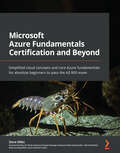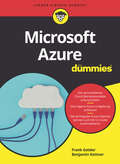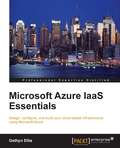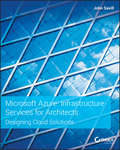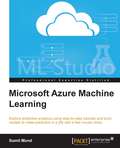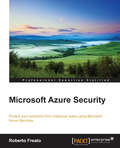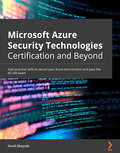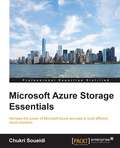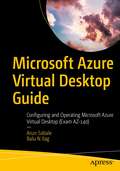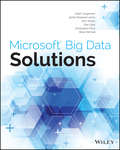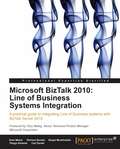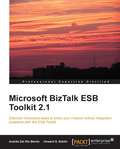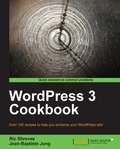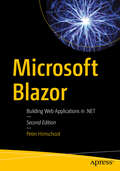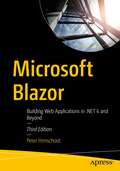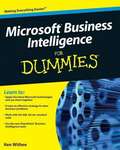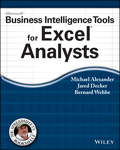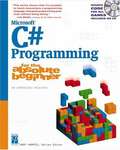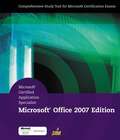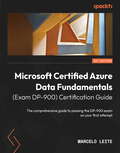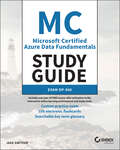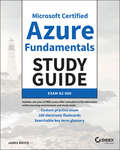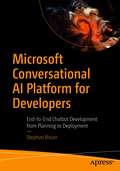- Table View
- List View
Microsoft Azure Fundamentals Certification and Beyond: Simplified cloud concepts and core Azure fundamentals for absolute beginners to pass the AZ-900 exam
by Steve Miles Peter De TenderGain in-depth knowledge of Azure fundamentals that will make it easy for you to achieve AZ-900 certificationKey FeaturesGet fundamental knowledge of cloud concepts and the Microsoft Azure platformExplore practical exercises to gain experience of working with the Microsoft Azure platform in the real worldPrepare to achieve AZ-900 certification on the first go with the help of simplified examples covered in the bookBook DescriptionThis is the digital and cloud era, and Microsoft Azure is one of the top cloud computing platforms. It's now more important than ever to understand how the cloud functions and the different services that can be leveraged across the cloud.This book will give you a solid understanding of cloud concepts and Microsoft Azure, starting by taking you through cloud concepts in depth, then focusing on the core Azure architectural components, solutions, and management tools. Next, you will understand security concepts, defense-in-depth, and key security services such as Network Security Groups and Azure Firewall, as well as security operations tooling such as Azure Security Center and Azure Sentinel. As you progress, you will understand how identity, governance, privacy, and compliance are managed in Azure. Finally, you will get to grips with cost management, service-level agreements, and service life cycles. Throughout, the book features a number of hands-on exercises to support the concepts, services, and solutions discussed. This provides you with a glimpse of real-world scenarios, before finally concluding with practice questions for AZ-900 exam preparation.By the end of this Azure book, you will have a thorough understanding of cloud concepts and Azure fundamentals, enabling you to pass the AZ-900 certification exam easily.What you will learnExplore cloud computing with Azure cloudGain an understanding of the core Azure architectural componentsAcquire knowledge of core services and management tools on AzureGet up and running with security concepts, security operations, and protection from threatsFocus on identity, governance, privacy, and compliance featuresUnderstand Azure cost management, SLAs, and service life cyclesWho this book is forThis Azure fundamentals book is both for those with technical backgrounds and non-technical backgrounds who want to learn and explore the field of cloud computing, especially with Azure. This book will also help anyone who wants to develop a good foundation for achieving advanced Azure certifications. There is no prerequisite for this book except a willingness to learn and explore cloud concepts and Microsoft Azure.
Microsoft Azure für Dummies (Für Dummies)
by Frank Geisler Benjamin KettnerDieses Buch erklärt Ihnen die Grundlagen von Azure, der Microsoft-Cloud-Technologie, und beschreibt klar und verständlich die grundlegenden Dienste. Nach der Lektüre können Sie die unterschiedlichen Cloud-Betriebsmodelle (Infrastructure as a Service, Platform as a Service und Software as a Service) unterscheiden und einschätzen. Sie kennen die wichtigsten Azure-Dienste und können dann eigene Azure-Umgebungen aufbauen. Damit Sie die Dienste auch automatisieren können, finden Sie im Buch viele Beispiele mit Azure CLI Code.
Microsoft Azure IaaS Essentials
by Gethyn EllisThis book is intended for system administrators and other IT professionals who need to both design and implement an Azure-based cloud solution. With the help of this book, you will soon master the basic tasks needed to build a cloud-based solution.
Microsoft Azure Infrastructure Services for Architects: Designing Cloud Solutions
by John SavillAn expert guide for IT administrators needing to create and manage a public cloud and virtual network using Microsoft Azure With Microsoft Azure challenging Amazon Web Services (AWS) for market share, there has been no better time for IT professionals to broaden and expand their knowledge of Microsoft’s flagship virtualization and cloud computing service. Microsoft Azure Infrastructure Services for Architects: Designing Cloud Solutions helps readers develop the skills required to understand the capabilities of Microsoft Azure for Infrastructure Services and implement a public cloud to achieve full virtualization of data, both on and off premise. Microsoft Azure provides granular control in choosing core infrastructure components, enabling IT administrators to deploy new Windows Server and Linux virtual machines, adjust usage as requirements change, and scale to meet the infrastructure needs of their entire organization. This accurate, authoritative book covers topics including IaaS cost and options, customizing VM storage, enabling external connectivity to Azure virtual machines, extending Azure Active Directory, replicating and backing up to Azure, disaster recovery, and much more. New users and experienced professionals alike will: Get expert guidance on understanding, evaluating, deploying, and maintaining Microsoft Azure environments from Microsoft MVP and technical specialist John Savill Develop the skills to set up cloud-based virtual machines, deploy web servers, configure hosted data stores, and use other key Azure technologies Understand how to design and implement serverless and hybrid solutions Learn to use enterprise security guidelines for Azure deployment Offering the most up to date information and practical advice, Microsoft Azure Infrastructure Services for Architects: Designing Cloud Solutions is an essential resource for IT administrators, consultants and engineers responsible for learning, designing, implementing, managing, and maintaining Microsoft virtualization and cloud technologies.
Microsoft Azure Machine Learning
by Sumit MundThe book is intended for those who want to learn how to use Azure Machine Learning. Perhaps you already know a bit about Machine Learning, but have never used ML Studio in Azure; or perhaps you are an absolute newbie. In either case, this book will get you up-and-running quickly.
Microsoft Azure Security
by Roberto FreatoThis book is intended for Azure administrators who want to understand the application of security principles in distributed environments and how to use Azure to its full capability to reduce the risks of security breaches. Only basic knowledge of the security processes and services of Microsoft Azure is required.
Microsoft Azure Security Technologies Certification and Beyond: Gain practical skills to secure your Azure environment and pass the AZ-500 exam
by David OkeyodeLearn how to implement multi-layered security controls to protect against rapidly evolving threats to Azure environmentsKey FeaturesDevelop practical skills to protect your organization from constantly evolving security threatsBecome well-versed with real-world Azure security strategies and AZ-500 exam objectivesEffectively manage security governance, policies, and operations in AzureBook DescriptionSecurity is a key part of any well-architected design. With the help of this book, you'll gain both the knowledge and the practical skills to significantly reduce the attack surface of your Azure workloads and protect your organization from constantly evolving threats to public cloud environments like Azure.This book is a comprehensive security guide for those looking to take the Azure Security Engineer certification exam as well as for those interested in securing their Azure infrastructure. Beyond preparing you for the Azure Security (AZ-500) exam, this book will guide you in securing your Azure environments and workloads using native Azure security capabilities.Complete with hands-on tutorials, projects, and self-assessment questions, this easy-to-follow guide builds a solid foundation of Azure security. You'll not only learn about security technologies in Azure but also be able to configure and manage them. Moreover, you'll develop a clear understanding of how to identify different attack vectors and mitigate risks.By the end of this book, you'll be well-versed with implementing multi-layered security to protect identities, networks, hosts, containers, databases, and storage in Azure.What you will learnManage users, groups, service principals, and roles effectively in Azure ADExplore Azure AD identity security and governance capabilitiesUnderstand how platform perimeter protection secures Azure workloadsImplement network security best practices for IaaS and PaaSDiscover various options to protect against DDoS attacksSecure hosts and containers against evolving security threatsConfigure platform governance with cloud-native toolsMonitor security operations with Azure Security Center and Azure SentinelWho this book is forIf you are a newly qualified or experienced security professional, cloud administrator, architect, or developer who wants to understand how to secure your Azure environment and workloads, this book is for you. The book is a handy resource for anyone preparing to take the Azure Security Engineer (AZ-500) certification exam. Foundational knowledge of the Azure cloud platform will be helpful but not necessary to understand the concepts covered in this book.
Microsoft Azure Storage Essentials
by Chukri SoueidiHarness the power of Microsoft Azure services to build efficient cloud solutions About This Book * Get to grips with the features of Microsoft Azure in terms of Blob, Table, Queue, and File storage * Learn the how and when of using the right storage service for different business use cases * Make use of Azure storage services in various languages with this fast-paced and easy-to-follow guide Who This Book Is For If you are an IT professional with basic knowledge of Microsoft Azure and want to learn Azure storage services, then this book is for you. Some familiarity with C# and Visual Studio is needed in order to utilize the examples present in the book. What You Will Learn * Get familiar with Windows Azure Storage Service in terms of architecture and working * Recognize the libraries and tools offered by Azure storage, supporting several popular programming languages * Know how the storage services expose their resources as REST APIs and what client libraries exists to develop against the storage * Gain the understanding of types of Blobs and best ways to upload and retrieve them * Learn how to make use of Tables as a NoSQL data store and how to retrieve, insert, update and delete entities in terms of design patterns * Use Queue storage as a messaging solution for communications between different apps * Create mounted shares and allow legacy systems to access data using the SMB protocol * Get accustomed to deal with faults, monitor storage metrics and logs In Detail With the many advantages of using cloud computing, Azure Storage is a robust platform that helps you shift faster to the cloud by providing scalable, durable and highly available data storage options. For developers, it provides a rapid development environment that supports building large-scale applications to support new scenarios on the cloud, server, mobile and web. For IT professionals, it reduces complexity of managing, protecting and replicating data. This book will make you familiar with the Azure storage in terms of architecture and components. It starts with the basics of storage accounts, which give access to the four basic services the Blob, Table, Queue, and File storage services. These services are exposed through a REST API that makes it possible for client libraries to implement most of their functionality in a wide range of popular programming languages. Emphasizing the Windows Azure Client Library for .NET, we will deal with storing and retrieving unstructured data with Blobs, then will move to Tables to insert and update entities in a structured NoSQL fashion. Then we will discover Queues as a reliable messaging service, and after that we will show File storage that allows you to migrate legacy applications data to the cloud to end with transient fault handling and service monitoring. Style and approach This book is a concise and fast-paced guide to learn about development for storage services. Each topic is elaborated sequentially, in order to create basic knowledge for using it in the right place and the correct way.
Microsoft Azure Virtual Desktop Guide: Configuring and Operating Microsoft Azure Virtual Desktop (Exam AZ-140)
by Arun Sabale Balu N IlagModernize your business to make it more agile using Azure Virtual Desktop (AVD). Azure Virtual Desktop is a cloud desktop virtualization platform that securely delivers virtual desktops and remote apps. This book will help you will help you to understand designing, implementing, configuring, and maintaining an Azure Virtual Desktop environment for enterprise and prepare to take the Microsoft AZ-140 certification exam. The book starts with an introduction to Azure Virtual Desktop and its design architecture. You will learn designing Azure Virtual desktop including user identities and profiles. Additionally, you will learn how to implement network for Azure Virtual desktop. Creation and configuration of host pools and session hosts is covered with all steps so that you can understand all options and select appropriate configuration for enterprise deployment. You will also go through session host images creation process and managing the image with image gallery and possible automation options. Managing access and security in AVD is discussed along with the installation, configuration, and management of FSLogix. The book will take you through user experience settings and show you how to configure apps on a session host. You will also learn about disaster recovery and how to automate AVD management tasks. Monitoring and managing performance is included as well as knowing how to use AVD automation to create and delete the host pool and session host. After reading this book, you will understand all aspects of AVD architecture, its implementation, monitoring, and management in preparation to take the AZ-140 exam. What You Will Learn Know what is Azure Virtual Desktop (or AVD) Design the Azure Virtual Desktop architecture for enterprise deployment, user identities, and profiles Plan and implement networking and storage for Azure Virtual Desktop Create, manage, and automate operating system images with image gallery Implement FSLogix Profile Containers and FSLogix Cloud Cache Create and configure host pools and session hosts (all detailed steps)Install and configure apps on a session host including all app publish optionsPlan and implement business continuity and disaster recovery Implement and manage OneDrive, Teams for a multi-session environmentMonitor and manage performance and health of Azure Virtual desktopWho This Book Is ForIT professional, Cloud administrators, support personnel, developers, DevOps engineers, architect, or consultant learning about designing, implementing, and managing Azure Virtual Desktop to improve knowledge or clear Microsoft AZ-140 exam.
Microsoft Big Data Solutions
by Dan Clark John Welch Christopher Price James Rowland-Jones Adam Jorgensen Brian MitchellTap the power of Big Data with Microsoft technologiesBig Data is here, and Microsoft's new Big Data platform is avaluable tool to help your company get the very most out of it.This timely book shows you how to use HDInsight along withHortonWorks Data Platform for Windows to store, manage, analyze,and share Big Data throughout the enterprise. Focusing primarily onMicrosoft and HortonWorks technologies but also covering opensource tools, Microsoft Big Data Solutions explains bestpractices, covers on-premises and cloud-based solutions, andfeatures valuable case studies.Best of all, it helps you integrate these new solutions withtechnologies you already know, such as SQL Server and Hadoop.Walks you through how to integrate Big Data solutions in yourcompany using Microsoft's HDInsight Server, HortonWorks DataPlatform for Windows, and open source toolsExplores both on-premises and cloud-based solutionsShows how to store, manage, analyze, and share Big Data throughthe enterpriseCovers topics such as Microsoft's approach to Big Data,installing and configuring HortonWorks Data Platform for Windows,integrating Big Data with SQL Server, visualizing data withMicrosoft and HortonWorks BI tools, and moreHelps you build and execute a Big Data planIncludes contributions from the Microsoft and HortonWorks BigData product teamsIf you need a detailed roadmap for designing and implementing afully deployed Big Data solution, you'll want Microsoft Big DataSolutions.
Microsoft BizTalk 2010: Line of Business Systems Integration
by Kent Weare Richard SeroterThis book will be a tutorial that focuses on integrating BizTalk with Line of Business systems using practical scenarios. Each chapter will take a Line of Business Adapter, introduce some pre-requisite knowledge and demonstrate how you can integrate BizTalk with that Line of Business Adapter, and then provide guidance based upon real world experience, taking your BizTalk knowledge further. The book will take "perceived" daunting scenarios, like integrating with SAP, and provide readers with a clear tutorial that walks them through integrating Line of Business systems.This book focuses on Microsoft BizTalk 2010; however, most of the concepts and explanations will apply to BizTalk 2006 R2 and BizTalk 2009.If you are an experienced BizTalk developer who wants to integrate BizTalk with Line of Business systems using practical scenarios, then this book is for you. A solid understanding of BizTalk at an intermediate level is required. This book assumes developers are comfortable creating schemas, maps, orchestrations, ports and messages in Visual Studio and configuring applications in the BizTalk Administration Console. However, experience in integrating with Line of Business systems is not necessarily required.
Microsoft BizTalk ESB Toolkit 2.1
by Howard S. Edidin Andres Del BenitoA practical guide into the architecture and features that make up the services and components of the ESB Toolkit.This book is for experienced BizTalk developers, administrators, and architects, as well as IT managers and BizTalk business analysts. Knowledge and experience with the Toolkit is not a requirement.
Microsoft BizTalk Server 2010 Patterns
by Dan RosanovaThis book is broken into two distinct parts. The first is a general introduction to BizTalk Server 2010 as well as the patterns commonly used in solutions built on the platform. It also includes explanations and motivations for these core patterns and practices. The second part is a hands-on real world example presented in a step-by-step manner that takes the reader through a multiphase solution and builds this simple project into a robust and complex middleware integration solution. This book is targeted at the professional developer or architect tasked with creating solutions that leverage BizTalk Server 2010. It assumes experience with Visual Studio and at least a minimal exposure to any version of BizTalk Server from 2004 to the present. Development managers with a technical background will also find this book useful in guiding their implementation teams. Cursory knowledge of XML, although useful, is not required; the text does include an XML primer in the appendix. Advanced BizTalk developers will learn many tips and techniques to improve the solutions they develop on the BizTalk 2010 platform.
Microsoft Blazor: Building Web Applications in .NET
by Peter HimschootBuild web applications in C# and Microsoft .NET that run in any modern browser. This second edition is updated to work with the release version of Blazor and covers Blazor’s use in creating both server-side and WebAssembly Blazor applications. Developers are able to use all their experience in .NET along with thousands of existing libraries, right in the browser. There is important new coverage in this edition on the new and improved Razor syntax, how to easily validate user input with Blazor validation, and how to build complex interacting components with Cascading Properties and Templated Components. You will learn how to build user interfaces and present data to a user for display and modification, capturing the user’s changes via data binding. The book shows you how to access a rich library of .NET functionality such as a component model for building a composable user interface, including how to develop reusable components that can be used across many pages and websites. Also covered is data exchange with a server, giving you access to microservices and database services. Blazor provides a fresh take on web development by eliminating the need for you to learn different languages and frameworks for client- and server-side development. Blazor allows C# and .NET to be used on all sides, providing a robust feature set that is well suited toward scalable, enterprise-level applications. This book gets you started using this important new toolkit for web application development.What You Will LearnBuild user interfaces and display data for users to editCapture the user’s changes via data bindingTransfer data back and forth between server and clientCommunicate with microservices and database servicesDevelop reusable components and assemble them into bigger componentsUse routing to build single-page applications (SPAs)Build Blazor libraries that are reusable across applicationsWho This Book Is ForExperienced .NET developers who want to apply their existing skills toward building professional-quality, client-side web applications that run in any browser. The book is for web developers who want to step away from JavaScript and its complexities, and instead use a proven technology (.NET) that is robust toward creating enterprise-quality applications that scale and are reliable, that provide good user experience.
Microsoft Blazor: Building Web Applications in .NET 6 and Beyond
by Peter HimschootBuild web applications in C# and Microsoft .NET 6 that run in any modern browser and become a full-stack web developer!. Do all these things using the Microsoft Blazor framework and the techniques shown in this book. New in this edition is coverage of the new and improved Razor syntax, communication with the server using SignalR and/or gRPC, the use of virtualization to load large quantities of data efficiently, deployment and ahead-of-time compilation into WASM, new unit testing features, security using OpenID Connect, and more. Reading this book helps you learn to build user interfaces and present data to a user for display and modification, capturing the user’s changes via data binding. The book shows how to access a rich library of .NET functionality such as a component model for building a composable user interface, including how to develop reusable components that can be used across many pages and websites. Also covered is data exchange with a server using REST, SignalR, and gRPC, giving you access to microservices and database services. Blazor provides a fresh take on web development by eliminating the need for you to learn different languages and frameworks for client- and server-side development. Blazor allows C# and .NET to be used on all sides—both server-side and client-side—providing a robust feature set that is well suited toward scalable, enterprise-level applications. With Blazor you can use all your experience in .NET 6 along with thousands existing libraries, right in the browser. This book gets you proficient using this important toolkit for web application development.What You Will LearnBuild user interfaces and display data for users to editCapture user edits and changes via data bindingTransfer data back and forth between server and clientCommunicate with microservices and database services using REST, SignalR, or gRPCDevelop reusable components and assemble them into bigger componentsUse routing to build single-page applications (SPAs)Build stable and maintainable software using unit testingInternationalize your application to reach more usersSecure your Blazor application with OpenID ConnectWho This Book Is ForExperienced .NET developers who want to apply their existing skills toward building professional-quality, client-side web applications that run in any browser and web developers who want to step away from JavaScript and its complexities, and instead use a proven technology (C# and .NET6) that is robust toward creating enterprise-quality applications that scale and are reliable, and provide a good user experience
Microsoft Business Intelligence For Dummies
by Ken WitheeLearn to create an effective business strategy using Microsoft's BI stackMicrosoft Business Intelligence tools are among the most widely used applications for gathering, providing access to, and analyzing data to enable the enterprise to make sound business decisions. The tools include SharePoint Server, the Office Suite, PerformancePoint Server, and SQL Server, among others.With so much jargon and so many technologies involved, Microsoft Business Intelligence For Dummies provides a much-needed step-by-step explanation of what's involved and how to use this powerful package to improve your business.Microsoft Business Intelligence encompasses a broad collection of tools designed to help business owners and managers direct the enterprise effectivelyThis guide provides an overview of SharePoint, PerformancePoint, the SQL Server suite, Microsoft Office, and the BI development technologiesExplains how the various technologies work together to solve functional problemsTranslates the buzzwords and shows you how to create your business strategyExamines related technologies including data warehousing, data marts, Online Analytical Processing (OLAP), data mining, reporting, dashboards, and Key Performance Indicators (KPIs)Simplifies this complex package to get you up and running quicklyMicrosoft Business Intelligence For Dummies demystifies these essential tools for enterprise managers, business analysts, and others who need to get up to speed.
Microsoft Business Intelligence Tools for Excel Analysts
by Michael Alexander Bernard Wehbe Jared DeckerBridge the big data gap with Microsoft Business Intelligence Tools for Excel AnalystsThe distinction between departmental reporting done by business analysts with Excel and the enterprise reporting done by IT departments with SQL Server and SharePoint tools is more blurry now than ever before. With the introduction of robust new features like PowerPivot and Power View, it is essential for business analysts to get up to speed with big data tools that in the past have been reserved for IT professionals. Written by a team of Business Intelligence experts, Microsoft Business Intelligence Tools for Excel Analysts introduces business analysts to the rich toolset and reporting capabilities that can be leveraged to more effectively source and incorporate large datasets in their analytics while saving them time and simplifying the reporting process.Walks you step-by-step through important BI tools like PowerPivot, SQL Server, and SharePoint and shows you how to move data back and forth between these tools and ExcelShows you how to leverage relational databases, slice data into various views to gain different visibility perspectives, create eye-catching visualizations and dashboards, automate SQL Server data retrieval and integration, and publish dashboards and reports to the webDetails how you can use SQL Server's built-in functions to analyze large amounts of data, Excel pivot tables to access and report OLAP data, and PowerPivot to create powerful reporting mechanismsYou'll get on top of the Microsoft BI stack and all it can do to enhance Excel data analysis with this one-of-a-kind guide written for Excel analysts just like you.
Microsoft C# Programming for the Absolute Beginner
by Andy HarrisThis book introduces C# programming through simple game creation and presents real-world scenarios to illustrate how these skills can be used in more practical C# programming applications. Tricks, traps, and boxes on real-world situations are included.
Microsoft® Certified Application Specialist: Microsoft® Office 2007 Edition
by Rachel Biheller Bunin Jennifer T. Campbell Barbara Clemens Pam Conrad Lisa RuffoloNIMAC-sourced textbook
Microsoft® Certified Application Specialist Study Guide: 2007 Microsoft Office System Edition
by Otsi<div xmlns="http://www.w3.org/1999/xhtml"><p>Get in-depth, all-in-one prep for the Microsoft Certified Application Specialist exams. Work through the tutorials and practice questions\u2014demonstrating your expertise in Microsoft Word 2007, Excel\xae 2007, Outlook\xae 2007, PowerPoint\xae 2007, and Access\xae 2007.</p></div>
Microsoft Certified Azure Data Fundamentals (Exam DP-900) Certification Guide: The comprehensive guide to passing the DP-900 exam on your first attempt
by Marcelo LeiteLearn how to implement successful Azure Data projects and get the skills to clear the DP-900 certification exam with the help of mock tests and self-assessment scenarios for better preparationKey FeaturesGet the knowledge you need to pass the DP-900 exam on your first attemptGain fundamental knowledge of the core concepts of working with data in Azure cloud data servicesLearn through a practical approach and test yourself with mock exams at the end of the bookBook DescriptionPassing the DP-900 Microsoft Azure Data Fundamentals exam opens the door to a myriad of opportunities for working with data services in the cloud. But it is not an easy exam and you'll need a guide to set you up for success and prepare you for a career in Microsoft Azure.Absolutely everything you need to pass the DP-900 exam is covered in this concise handbook. After an introductory chapter covering the core terms and concepts, you'll go through the various roles related to working with data in the cloud and learn the similarities and differences between relational and non-relational databases. This foundational knowledge is crucial, as you'll learn how to provision and deploy Azure's relational and non-relational services in detail later in the book. You'll also gain an understanding of how to glean insights with data analytics at both small and large scales, and how to visualize your insights with Power BI. Once you reach the end of the book, you'll be able to test your knowledge with practice tests with detailed explanations of the correct answers.By the end of this book, you will be armed with the knowledge and confidence to not only pass the DP-900 exam but also have a solid foundation from which to embark on a career in Azure data services.What you will learnExplore the concepts of IaaS and PaaS database services on AzureQuery, insert, update, and delete relational data using SQLExplore the concepts of data warehouses in AzurePerform data analytics with an Azure Synapse Analytics workspaceUpload and retrieve data in Azure Cosmos DB and Azure HDInsightProvision and deploy non-relational data services in AzureContextualize the knowledge with real-life use casesTest your progress with a mock examWho this book is forThis book is for data engineers, database administrators, or aspiring data professionals getting ready to take the DP-900 exam. It will also be helpful for those looking for a bit of guidance on how to be better equipped for Azure-related job roles such as Azure database administrator or Azure data engineer. A basic understanding of core data concepts and relational and non-relational data will help you make the most out of this book, but they're not a pre-requisite.
Microsoft Certified Azure Data Fundamentals Study Guide: Exam DP-900
by Jake SwitzerThe most authoritative and complete study guide for people beginning to work with data in the Azure cloud In MC Azure Data Fundamentals Study Guide: Exam DP-900, expert Cloud Solution Architect Jake Switzer delivers a hands-on blueprint to acing the DP-900 Azure data certification. The book prepares you for the test – and for a new career in Azure data analytics, architecture, science, and more – with a laser-focus on the job roles and responsibilities of Azure data professionals. You’ll receive a foundational knowledge of core data concepts, like relational and non-relational data and transactional and analytical data workloads, while diving deep into every competency covered on the DP-900 exam. You’ll also get: Access to complimentary online study tools, including hundreds of practice exam questions, electronic flashcards, and a searchable glossary Additional prep assistance with access to Sybex’s superior interactive online learning environment and test bank Walkthroughs of skills and knowledge that are absolutely necessary for current and aspiring Azure data pros in introductory rolesPerfect for anyone just beginning to work with data in the cloud, MC Azure Data Fundamentals Study Guide: Exam DP-900 is a can’t-miss resource for anyone prepping for the DP-900 exam or considering a new career working with Azure data.
Microsoft Certified Azure Fundamentals Study Guide: Exam AZ-900
by James BoyceQuickly preps technical and non-technical readers to pass the Microsoft AZ-900 certification exam Microsoft Certified Azure Fundamentals Study Guide: Exam AZ-900 is your complete resource for preparing for the AZ-900 exam. Microsoft Azure is a major component of Microsoft’s cloud computing model, enabling organizations to host their applications and related services in Microsoft’s data centers, eliminating the need for those organizations to purchase and manage their own computer hardware. In addition, serverless computing enables organizations to quickly and easily deploy data services without the need for servers, operating systems, and supporting systems. This book is targeted at anyone who is seeking AZ-900 certification or simply wants to understand the fundamentals of Microsoft Azure. Whatever your role in business or education, you will benefit from an understanding of Microsoft Azure fundamentals. Readers will also get one year of FREE access to Sybex’s superior online interactive learning environment and test bank, including hundreds of questions, a practice exam, electronic flashcards, and a glossary of key terms. This book will help you master the following topics covered in the AZ-900 certification exam: Cloud concepts Cloud types (Public, Private, Hybrid) Azure service types (IaaS, SaaS, PaaS) Core Azure services Security, compliance, privacy, and trust Azure pricing levels Legacy and modern lifecycles Growth in the cloud market continues to be very strong, and Microsoft is poised to see rapid and sustained growth in its cloud share. Written by a long-time Microsoft insider who helps customers move their workloads to and manage them in Azure on a daily basis, this book will help you break into the growing Azure space to take advantage of cloud technologies.
Microsoft® CLR via C#, Second Edition
by Jeffrey Richter<div xmlns="http://www.w3.org/1999/xhtml"><p>Your hands-on guide to developing applications with the common language runtime (CLR) and Microsoft .NET Framework 2.0, with examples in Microsoft Visual C# 2005.</p></div>
Microsoft Conversational AI Platform for Developers: End-to-End Chatbot Development from Planning to Deployment
by Stephan BisserBuild a chatbot using the Microsoft Conversational AI platform. This book will teach you, step by step, how to save time and money by including chatbots in your enterprise's strategy. You will learn how to be proficient at every phase of development, from collaboration on a chatbot in an end-to-end scenario, to the first mock-up phase, and on through to the deployment and evaluation phases.Microsoft built a cloud service ecosystem for running artificial intelligence workloads in public cloud scenarios and a robust AI platform that offers a broad range of services targeting conversational artificial intelligence solutions such as chatbots.Building a chatbot requires not just developer coding skills but special considerations, including input from business stakeholders such as domain matter experts and power users. You will learn by example how to use a great set of tools and services to bridge the gap between business and engineering.You will learn how to successfully morph business requirements into actionable IT and engineering requirements. You will learn about Bot Framework Composer, which allows power users to initiate the building of a chatbot that can then be handed over to the development team to add capabilities through code. Coverage is given to the process of sharing implementation tasks and workloads between power users, who are using a low-code or no-code approach, and developers, who are building out the enhanced features for the chatbot.What You Will LearnUnderstand Microsoft’s comprehensive AI ecosystem and its services and solutionsRecognize which solutions and services should be applied in each business scenarioDiscover no-code/low-code approaches for building chatbotsDevelop chatbots using the conversational AI stackAlign business and development for improved chatbot outcomes and reduced time-to-marketWho This Book Is ForDevelopers and power users who want to build chatbots. An understanding of the core principles of writing code (.NET or JavaScript) for modern web applications is expected.
